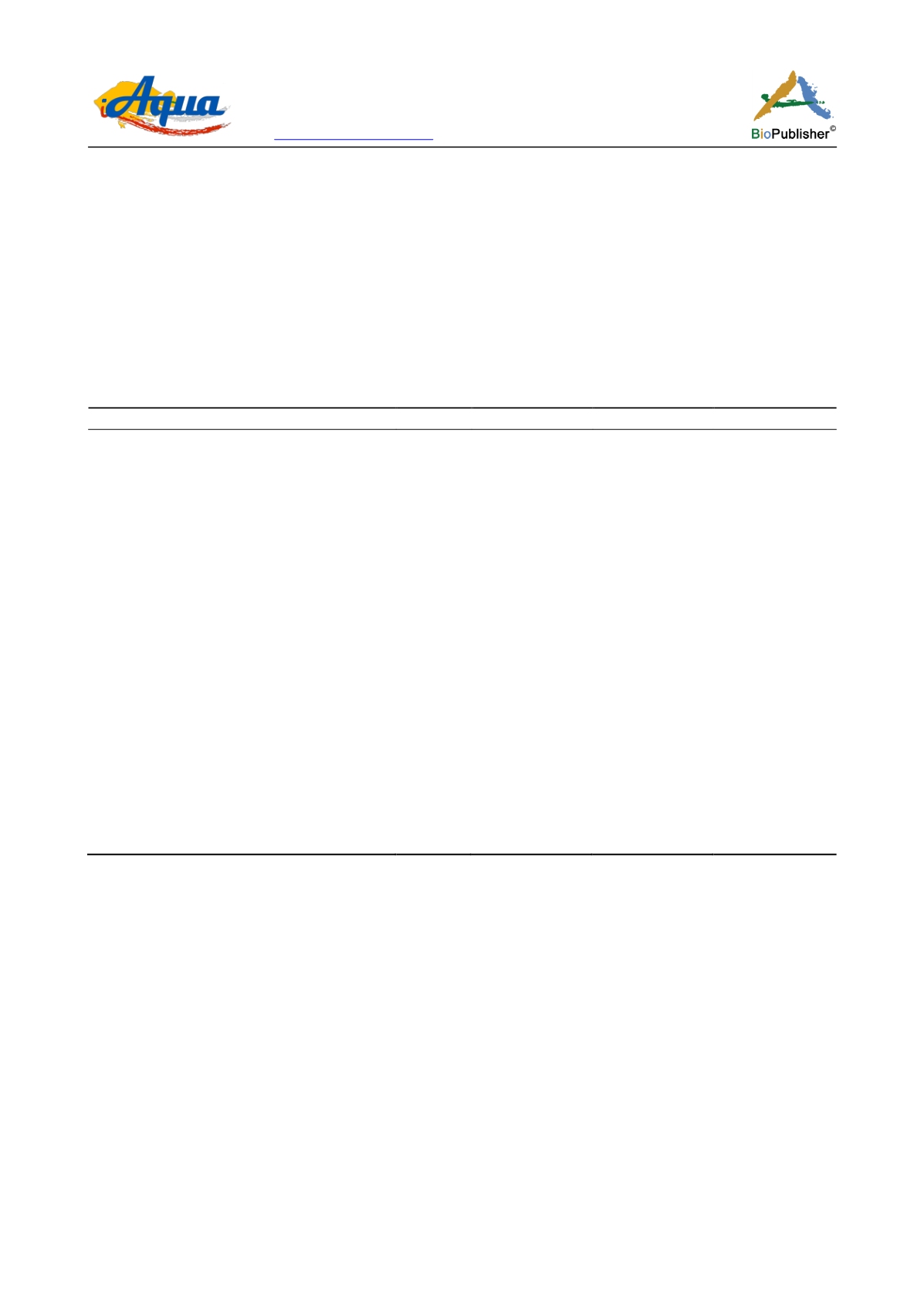
International Journal of Aquaculture, 2017, Vol.7, No. 2, 9
-
14
12
consumed by the fish is a function of its size, feeding rate, activity level and temperature. DO in a culture system
must be maintained above levels considered stressful to fish. Fish require oxygen for respiration. Oxygen
depletion in water leads to poor feeding of fish, starvation, reduced growth and more fish mortality, either directly
or indirectly (Bhatnagar and Garg, 2000). The results from this study indicated that there was no significant
difference (p > 0.05) in DO between culture systems and also between season (p > 0.05). According to Santhosh
and Singh (2007), catfishes and other air breathing fishes can survive in low oxygen concentration of 4 mg/L.
Ekubo and Abowei (2011) recommended that fish can die if exposed to less than 0.3 mg/L of DO for a long
period of time, minimum concentration of 1.0 mg/L D.O is essential to sustain fish for long period and 5.0 mg/L
are adequate in fish ponds. Prolonged exposure to low DO will cause the fish to stop feeding, reduce their ability
to convert ingested food into fish flesh and make them more susceptible to disease (Joseph et al., 1993).
Table 5 ANOVA results for mean water quality parameters of fish pond
Variables
df
Ms
F
P level
pH
Culture systems
1
0.079 380
0.254 939
0.620 101
Season
1
0.151 380
0.486 177
0.495 064
Temperature
Culture systems
1
15.138 00
7.768 232
0.012 642*
Season
1
2.312 00
1.186 428
0.291 252
Dissolved Oxygen
Culture systems
1
47.308 88
0.446 132
0.513 144
Season
1
59.581 52
0.561 865
0.463 757
Total Dissolved Solids
Culture systems
1
649.80
0.293 760
0.594 855
Season
1
17 523.20
7.921 838
0.011 933*
Nitrite
Culture systems
1
0.005 780
0.386 212
0.542 542
Season
1
0.002 880
0.192 43
0.666 420
Nitrate
Culture systems
1
17.521 92
3.370 442
0.839 30
Season
1
30.405 78
5.848 726
0.027 097*
Ammonia
Culture systems
1
0.648 000
14.193 68
0.001 536*
Seasons
1
0.008 000
0.175 23
0.680 745
Note: *, denotes significance levels at 5% level
Ammonia:
Ammonia is the by-product from protein metabolism excreted by fish and bacterial decomposition of
organic matter such as wasted food, faeces, dead planktons, sewage and others. The unionized form of ammonia
(NH
3
) is extremely toxic while the ionized form (NH
4
+
) is not and both the forms are grouped together as “total
ammonia” (Bhatnagar and Devi, 2013). Ammonia levels depend on the temperature of the pond’s water and its
pH (Joseph et al., 1993). Mean value of ammonia obtained in this study was between 0.4 ±0.08 mg/L and 0.6 ±
0.03 mg/L for EPs and CTs, respectively. Ammonia in the range > 0.1 mg/L tends to cause gill damage, destroy
mucous producing membranes, “sub- lethal” effects like reduced growth, poor feed conversion, reduced disease
resistance at concentrations that are lower than lethal concentrations, osmoregulatory imbalance, and kidney
failure. Stone and Thomforde (2004) stated the desirable range as Total NH
3
-N (0.2 mg/L) and Un-ionized NH
3
-N
(0 mg/L) and acceptable range as Total NH
3
-N (< 4 mg/L) and Un-ionized NH
3
-N (< 0.4 mg/L). Bhatnagar and
Singh (2010) recommended the level of ammonia (<0.2 mg/l) suitable for pond fishery. Ammonia was
significantly different among the culture systems (values were higher in CTs than EPs).
Total Dissolved Solids
(TDS):
TDS refers to any matter either suspended or dissolved in water. Dissolved solids
include; bicarbonate, sodium, organic ions and other ions in sustaining aquatic life. TDS in culture systems ranged


